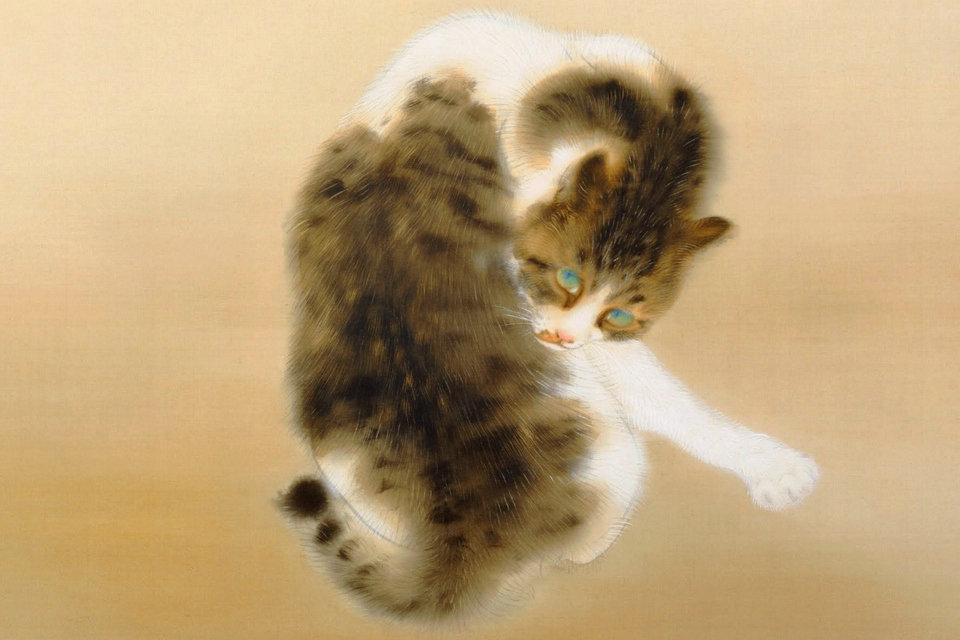Animals of Modern Japanese Painting, Yamatane Museum of Art


Japanese have long been fascinated by “life” living creatures such as animals, birds, insects, and have drawn their appearance. Apart from the flower and bird paintings introduced from China, there are sacred elephants and lions in Buddhist paintings, Kirin on legends, Feng Takeuchi Soufu Matsuo (Hoou), Dragon tiger in Zen sect, Japan Sometimes animals in the painting were closely related to religion and faith. Meanwhile, animals in modern Japanese paintings will be freely expressed as a unique figure that is depicted more graphically and felt by the writer’s line of sight, based on this tradition.
Puppies, rabbits, cats, mammals such as monkeys and cows, and elegant birds such as peacocks, mackerels, and herons. And insects such as butterflies, insects, carps, snakes, frogs, fish, reptiles (amulets) and amphibians. Even if I say “one thing” in a word, its kind is quite varied and full of the radiance of each life.
The white peacock of Mamuramatsu 上 of Umi Matsumoto, a beautiful woman with pure white feathers dressed in Yamaguchi Huayang “Kisame (Kodama)” quietly standing in a shiny air. The white rabbit and the black cat are symbolically drawn on the gold screens of decorative screen composition “Hot water moss green”. “Chicks” of Aomi Komodada, where adorable chicks and children of human society overlap. Kenji Yoshioka ‘s “floating” which makes me feel like a couple in a crowd. Kobayashi old-fashioned “cat” whose body is tightened to the line of sight of the cat stretched the back straight.
In this exhibition, this summer, as a plan that children can enjoy, we will introduce about 50 fun and lovely “Ikimono” to everyone. I hope you will visit us and find your favorite animals.
Exhibited works: Kano Kazuki “Furong Shirasagi”, Takeuchi Uuho “Frog and dragonfly”, Yokoyama Taikan “Turning bird”
Kawai Tamado “duck”, Kobayashi old diameter “cat”, Yasuhiko Yasuda “Usagi”, Aoki Komoda “Hina”,
Hayami Miku “Ridge Moss Green Grass”, Yamaguchi Huayang “Wooden”, Uemura Matsuko “White Peacock”,
Kenji Yoshioka “Floating”, Taichi Sato “Rhymes”, Koichi Takeuchi “Monkey Figure”,
In 1966 (Showa 41), under the philosophy of “Yamato Art Museum’s” I would like to contribute to society, especially culture, through art, we opened as the first museum specializing in Japanese painting nationwide. Since then, we have been working on collection, research, publication and dissemination around modern and contemporary Japanese paintings for about half a century until today.
Japanese painting is an art using natural materials such as rock paint and Japanese paper. In the subject and expression, the beauty of nature and the feeling of the season are valued, reflecting the traditional aesthetic sense of Japan cultivated in living with nature. The Yamato Art Museum hopes to convey the appeal of Japanese paintings polished over a long time in the unique nature and climate of Japan to as many people as possible regardless of age, gender, or nationality thinking about. In addition, we would like to develop various activities so that we can take over Japanese painting to the future.
In the 21st century, the society and the environment surrounding us are undergoing drastic changes, such as globalization, information technology, and innovation rapidly progressing. Under such circumstances, the importance of cultures and arts that enrich people’s minds is reviewed, and the role played by museums that play a part of that is questioned once more. Through all kinds of activities including exhibitions and educational dissemination, the hotel aims to be an art museum where people can convey excitement, discoveries, joy and peace to people by communicating the splendor of Japanese painting and Japanese culture.
The philosophy of the Yamato Art Museum’s “I would like to contribute greatly to society, especially culture, through arts” as the core, clearly expresses the spirit and common values that have been handed down and established the basic philosophy of the Yamaguchi Museum of Art. Also, I wanted to disseminate the wonderfulness of Japanese painting widely, and added a new symbol mark (design: Taku Sato) to the traditional logo. In addition, we carried out the “Seed Mountain Art Museum Nippon Painting Award 2016”, which was once used and restarted the “Yamami Art Museum Award” in a form suitable for a new era. This award is planned to be held continuously and we hope to help bring Japanese painting to the future and tell the world.
“It is my wishes that if you can taste the goodness of the Japanese painting widely also for those who love art, or those who have not had much contact with you, it is actually my wish.” In addition to inheriting the thought of this founder, we aim to disseminate Japanese paintings in the 21st century, and we are doing various initiatives from exhibitions and educational promotion activities to information dissemination utilizing the Internet.
Culture and art can enrich people’s mind. In the 21st century, as globalization progresses, we think that we will continue to engage in even more meaningful activities in the international community by widely disseminating the charm of Japanese painting, which is a property inherent in Japan, both in Japan and abroad. We hope to continue to promote and develop Japanese culture and academic through various activities, from exhibitions with friendly themes to steady research.